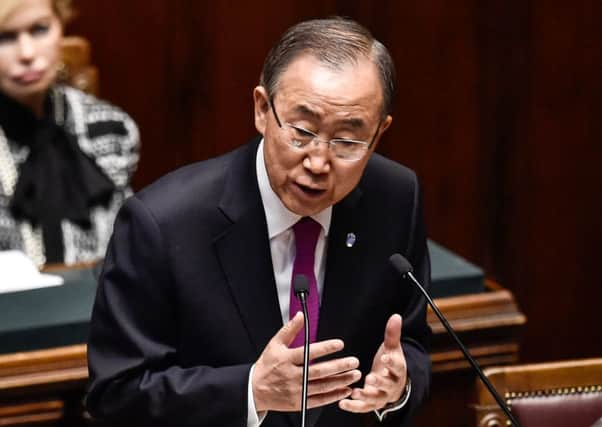May East: New goals will help lead work to eradicate poverty


The race to end poverty begins here and now “Climate change is destroying our path to sustainability. Ours is a world of looming challenges and increasingly limited resources. Sustainable development offers the best chance to adjust our course.” UN secretary-general Ban Ki-moon
For 15 years, the Millennium Development Goals (MDGs) have served as the baseline for the international community’s approach to sustainable development. They will expire in December, replaced by a new set of Sustainable Development Goals (SDGs) - also known as the Global Goals – that comprise 17 goals for global dignity, prosperity, partnership, and justice for all people.
Advertisement
Hide AdAdvertisement
Hide AdThe new set of Global Goals will be adopted by heads of state at the UN General Assembly this autumn and will apply to all countries, reflecting a universal determination to eradicate all poverty, in all its forms, everywhere by 2030, and to do so in a way that moves us to a more environmentally sustainable economy. While the MDGs were largely funded by voluntary aid donations – perpetuating a dependence on donor-recipient relationships - the SDGs have sustainable economic development at their core, stimulating the ability of countries to address social challenges largely through improving their own revenue generating capabilities.
The breadth and depth of the proposed SDGs is unprecedented. Adopting a rights-based approach, the new agenda aims to leave no-one behind and promote social inclusion for the most vulnerable groups. At the same time, it is expected to set the environmental limits and critical natural thresholds for the use of natural resources.
A conference in Addis Ababa in July set out the means of implementing the new agenda, with an unfeasibly expensive estimated cost of $2-$3 trillion a year of public and private money, over 15 years. At a time of austerity, governments will view these projections with alarm. But can we afford not to foot the bill? Back in the 1990s, it was estimated that Agenda 21 – the sustainable development plan that arose from the Rio Summit – would cost around $625 billion a year to implement. States baulked at such a price tag. But it was a false economy. Twenty years of inaction has increased the costs and brought us to the brink of crisis.
Between now and 2030, the SDGs aim to end poverty and hunger once and for all; to fight inequalities; to ensure the lasting protection of the planet; and to create conditions for a strong economy and shared prosperity.
The critical question to be addressed is how we balance these competing objectives. It is clear that we cannot afford an approach based on ever-increasing levels of extraction, production and consumption. An increasing number of voices advocate a systemic shift towards sustainable lifestyles while decreasing the use of resources and waste emissions.
This is echoed by the Pope’s Encyclical on climate change which argues that “we have not yet managed to adopt a circular model of production capable of preserving resources for present and future generations, while limiting as much as possible the use of non-renewable resources, moderating their consumption, maximizing their efficient use, reusing and recycling them”.
As with all intergovernmental agreements, the success of these goals will be determined by the willingness of governments to implement them.
First Minister Nicola Sturgeon has said the Scottish Government “is actively promoting a vertical integration system that aims to align the UN SDG’s with its National Performance Framework, under which all services and local policies are to be framed”. At a local level, the Moray Council has recently reviewed the targets and priorities in its 10 year plan to ensure they are aligned with the SDGs and the National Framework, the first local authority to do so.
Advertisement
Hide AdAdvertisement
Hide AdThe SDGs are the result of an uneasy compromise. They nevertheless represent a once in a generation opportunity for transformational change. The key challenge is how to engage the public in support of a complex agenda consisting of 17 goals and 169 targets.
The UN is currently rolling out a major advertising campaign led by film writer and director Richard Curtis and a Global Citizen Festival, featuring Beyonce, Coldplay and Ed Sheeran, will take place in New York later this month. And in Scotland, CIFAL has partnered with Young Scot to launch the campaign ‘A Thriving Planet Leaves No One Behind.’ Over 17 weeks, Young Scots will be engaged in a series of activities related to the global goals.
• May East is chief executive of Cifal Scotland